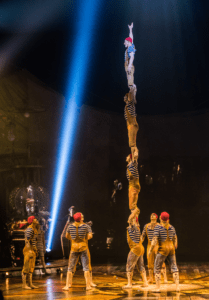Fans of Cirque du Soleil know to expect wonder, beauty, and thrills, and Cirque doesn’t disappoint. It’s a brilliantly executed brand that has become a global phenomenon (21 different productions are currently touring or installed in long runs somewhere). Each of Cirque’s shows is singular, unlike any other; yet they are all incubated within a similar creative vision and utilize a toolkit of recurring theatrical techniques. It’s a performance form that blends music, choreography, design, acrobatics, characters, and storytelling/mythmaking into a spectacle that is both singular and familiar.

But once you’ve seen one, don’t think you’ve seen them all. Once you see one, you just want to see more. That’s what happened when I caught my first Cirque show (or it caught me), and that’s what happens every time I see another. (My last was Amaluna two too-long years ago.)
If you’ve never been to a Cirque show, Kurios – Cabinet of Curiosities, just opened in Tysons Corner two blocks from the Silver line stop, would be a perfect place to start. And for those who’ve seen some Cirque before, Kurios’ marvels will not only wow one’s inner kid-at-the-circus, as all Cirque shows do. Kurios’ artistic achievement will also enchant adventurous theater folk with its sophisticatedly trippy mix of imagery from cinema and steampunk.
A signature of each Cirque show is its distinctive look. Cirque keeps coming up with one such eye-popping world after another. And the specific ambiance created by the design team of Kurios—Cirque’s 35th production since 1984—is sensational.

Kurios bears an uncanny visual and thematic resemblance to the 2011 film Hugo: It’s an imagined surreality filled with period gizmos, toybox thingamajigs, and industrial mechanical devices; and there’s a central character who’s trying to make sense of it all. In Hugo, it was an imperiled boy; in Kurios, it’s a tinkerer called the Seeker, whose curio cabinet contains a cast of quirky characters who come to life and spill out on stage to provide the evening’s enthralling entertainment.
Other influences can be espied in the show and are hat-tipped in a production backgrounder: For the set, Jules Verne and Thomas Edison; for the costumes, the Bauhaus, Alfred Jarry’s play Father Roi, the Franco-Belgian cartoon character Obelix, Fritz Lang’s film Metropolis, and French illusionist and film director Georges Méliès; the 19th-century Industrial Revolution for props and the acrobats’ apparatus. Theatergoers and theater makers who love artful aggregations of styles and images that nonetheless cohere will have a field day watching Kurios. It’s like a master class in mashup.
The music is magnificent, well worth a listen beforehand. And as with all Cirque shows, there are plenty of large-scale acts that fill the stage and its air space with heart-stopping feats of tumbling, balancing, bouncing, flying. A few highlights:
• The Russian Cradle Duo, in which a hulking man serves as human trapeze for a diminutive woman, whom he swings and flings through the air in a most amazingly graceful display of trust.
• Aerial Straps, in which two strapping shirtless men fly suspended above the stage and the audience now apart now together, now distant then entwined, in a most awesome athletic/erotic flight of fancy.
• Banquine, in which 13 acrobats bound onto each other’s shoulders, not by means of teeterboard but by muscular lifting, and then, among other stunts, stand one atop another up to four high.
Kurios also features what seemed to me an unusually high number of smaller-scale acts—the sort that are equivalent to a magician’s card tricks as opposed to huge illusions. I found these riveting, and one of the most original and rewarding aspects of the show. For instance:
• Yo-yos, in which a solo performer commands the rapt attention of the audience solely by spinning suspense from a couple yo-yos, in time with fast flamenco-like guitar.
• Theater of Hands. This one blew me away. A hot air balloon inflates as it descends from the tent’s fly space. It then becomes the projection screen for real-time video closeups of human hands that are brought to life by off-camera artists and become human-like puppets. Their miniature storytelling is utterly magical.

No Cirque show would be complete without comedy and Kurios features some of Cirque’s most original, including:
• Comic Act, which involved a sofa, a crazy-antic comedian, and the participation of an audience member. Like a fast-paced improv sketch, it had the audience member bemused and the audience howling.
• Invisible Circus, which was basically a solo ringmaster character working with sound effects and a big set piece that had been built full of sight gags to create hilarious illusions of an unseen unicyclist, lion tamer, high diver, and such. I doubt any scene shop has ever supplied so many laughs a minute.
Curiously, for a production that’s got far more than a cabinet’s worth of things in it (machines, engines, scientific equipment, animated set pieces) plus an oddball assortment of thing-like characters (Accordion Man, a pair of robots), Kurios turns out to be among Cirque’s most personal and human-scale productions.
For fans and fans-to-be, Cirque du Soleil’s Kurios – Cabinet of Curiosities is both classically spectacular and captivatingly fresh.
Running Time: Two hours 15 minutes, with one 25-minute intermission.
Kurios – Cabinet of Curiosities plays through September 18, 2016, under the blue and yellow Big Top at Tysons II, 8025 Galleria Dr., Washington, Virginia 22102. Tickets are available online. For booking assistance call (877) 924-7783.
RATING:




